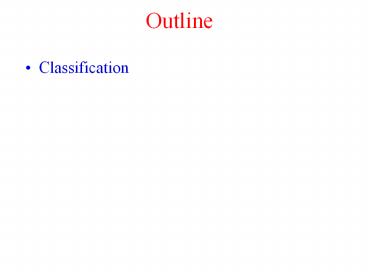Outline - PowerPoint PPT Presentation
1 / 21
Title:
Outline
Description:
Outline Classification – PowerPoint PPT presentation
Number of Views:41
Avg rating:3.0/5.0
Title: Outline
1
Outline
- Classification
2
Pattern Recognition
- It is natural and desirable that we should seek
to design and build machines that can recognize
patterns - Automated speech recognition
- Fingerprint identification
- Optical character recognition
- DNA sequence identification
3
An Example
- Fish sorting
- A fish-packing plant wants to automate the
process of sorting incoming fishes on a conveyor
belt according to species using optical sensing - Separate sea bass from salmon
- Physical differences between sea bass and salmon
- Length, lightness, width, number and shape of
fins, position of mouth ..... - Noise
4
Components of A Recognition System
- A Typical pattern recognition system
- Input
- Sensing
- Segmentation
- Feature extraction
- Classification
- Post-processing
5
Sensing
- The input to the recognition system
- Digital cameras
- Lasers
- Some kind of a transducer
- Characteristics and limitations of the transducer
- Its bandwidth
- Resolution
- Sensitivity
- Distortion
- Signal-to-noise ratio
6
Segmentation and Grouping
- Segmentation
- To segment out the object we are interested in
from all other objects - This is a very difficult problem
- Grouping
- Group pixels that correspond to an object
together - Perceptual organization
- Figure-ground segregation
7
Feature Extraction
- Features
- Some characteristics of the input that can
separate objects in different types very
effectively - Invariant features
- Translation invariance
- Rotation invariance
- Scale invariance
- Occlusion
- Projective distortion
8
Feature Extraction cont.
- Deformation
- Domain specific highly complex transformations
- Feature extraction is domain specific
- That is, good features depend on what you want to
do - Feature selection
- Techniques to select the best features among a
set of features
9
Training
- Design or training samples
- One needs to make measurements of each pattern
class - This is often done by specifying examples
10
Classification
- Definition
- Given a set of classes, represented by the
corresponding feature values, assign the new
input object to a category - The degree of the difficulty depends on the
variability in the feature values for objects in
the same object with respect to the difference
between feature values for objects in different
categories
11
Post-Processing
- Post-processing makes recommendations or takes
actions based on the output from the classifier - Error rate
- Risk
- Cost of a mistake
- Context
- Multiple classifiers
12
Design Cycles
- Data collection
- Feature choice
- Prior knowledge
- Model choice
- Training
- Evaluation
- Over-fitting
13
Computational Complexity
- Pattern recognition problems can be solved
using algorithms that are highly impractical - Polynomial vs. exponential
- The computational resources needed and
computational complexity are of practical
importance - The system may have to make a decision within a
time interval
14
Learning and Adaptation
- Supervised learning
- There is a teacher which provides a category
label for each pattern in a training set - Unsupervised learning
- There is no explicit teacher
- The system forms clusters of the input patterns
- Reinforcement learning
- Some feedback information about the systems
performance
15
Neural Networks
- Based on the connections in the brain
16
Neural Networks cont.
17
Statistical Pattern Recognition
- Given a set of features and cost associated with
each decision, classification is to decide a
decision boundary in the feature space or make a
decision rule - We want to minimize the total cost
- Generalization
- The classifier is designed to suggest actions for
novel patterns
18
Pattern Theory
- Pattern theory proposed by Ulf Grenander
- The analysis of the patterns generated by the
world in any modality, with all their naturally
occurring complexity and ambiguity, with the goal
of reconstructing the processes, objects and
events that produced them and of predicting these
patterns when they reoccur
19
Bayesian Decision Rule
- A two-class example
- ?1 for sea bass
- ?2 for salmon
- Prior probability
- P(?1)
- P(?2)
20
Bayesian Decision Rule cont.
- Class conditional probability density
- P(?1 x)
- P(?2 x)
- Bayes formula
21
Bayesian Decision Rule cont.
- Bayes decision rule
- Decide ?1 if P(?1 x) gt P(?2 x)
- Otherwise decide ?2
- The optimal decision rule
- Minimize the average error we make
























![[READ]⚡PDF✔ Black Letter Outline on Contracts (Black Letter Outlines) 5th Edition PowerPoint PPT Presentation](https://s3.amazonaws.com/images.powershow.com/10044064.th0.jpg?_=20240531080)

![[PDF] DOWNLOAD FREE Clinical Outline of Oral Pathology: Diagnosis and PowerPoint PPT Presentation](https://s3.amazonaws.com/images.powershow.com/10076578.th0.jpg?_=20240711025)




